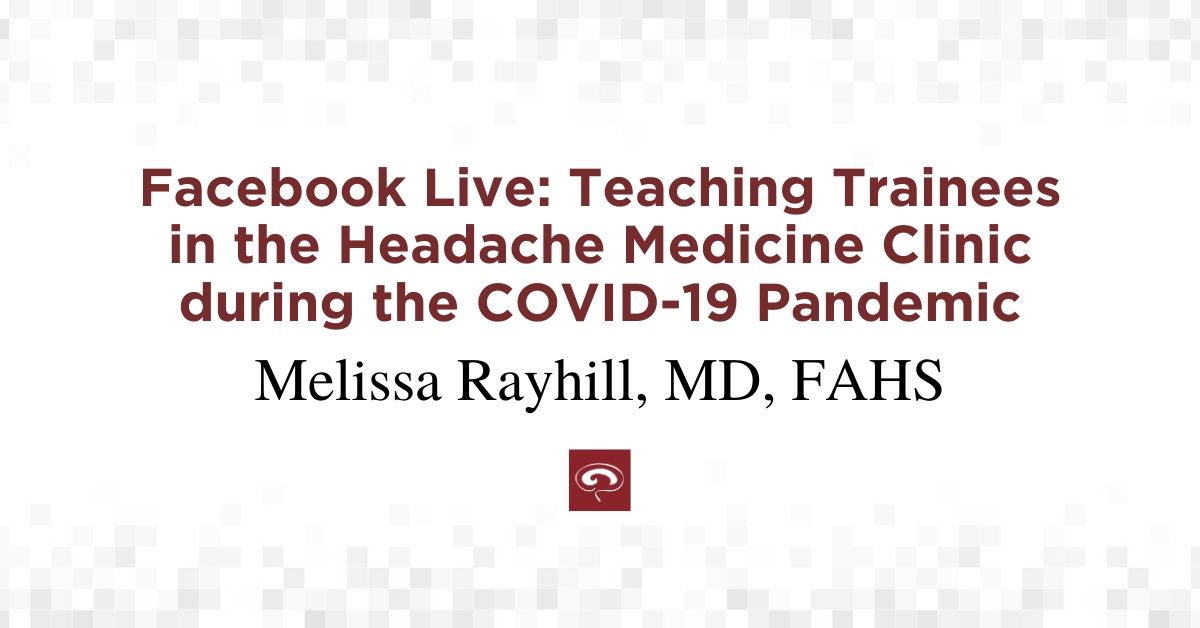
Trainee Education During the COVID-19 Pandemic
Melissa Rayhill, MD, FAHS, discusses how to best tailor virtual educational opportunities to the headache medicine clinic
The COVID-19 pandemic has ushered in changes in healthcare protocol to keep both patients and practitioners safe. It has also caused institutions of medical education to search for ways to further trainee education during the COVID-19 pandemic while maintaining safety. Melissa Rayhill, MD, FAHS, a neurologist and assistant professor at the University of Buffalo School of Medicine, hosted a Facebook Live where she discussed practices and strategies to adapt neurology instruction to a virtual setting.
Dr. Rayhill recommends sitting down at your institution as a team and discussing, “What is required in-person versus virtually to meet their needs and provide adequate care?” At SUNY Buffalo, they decided to postpone in-person requirements and focus 100% on virtual medical education. The institution made this decision to keep students safe and best abide by stay-at-home orders and recommendations for physical distancing. Learn how her institution has adapted learning to suit a virtual setting through the video below.

Virtual Accommodations for Medical Students
Dr. Rayhill explains that medical students can tune in virtually. But it’s also beneficial to space lectures out with opportunities for them to interact. Zoom works well for small group break-out sessions where students can talk with their peers to answer provided questions, just like they would do in person at medical school. Dr. Rayhill suggests recording often-repeated lectures using video recording software like Panopto to save time and also provide the students with the opportunity to revisit the material as needed.
For SUNY Buffalo’s fourth-year medical students, who typically have a significant in-person rotation, the institution made adjustments to instruction. This includes group presentations on key topics in neurology with eight to 10 students and four faculty members per session. Other Buffalo clerkships rely on virtual table rounds for inpatient services, where students talk to patients remotely. Such a service allows students access to this important piece of their education while safely at home.
Virtual Accommodations for Residents
Dr. Rayhill says institutions should limit in-person visits for residents as soon as possible for their safety. Residents can often achieve their educational requirements using a telemedicine platform for virtual visits per the ACGME. This extends not only to headache medicine, but also neurology. Institutions should experiment with the various options to determine which works best for their needs. Dr. Rayhill is using doxy.me because it allows users to open different tabs for each resident’s clinic and also has the functionality for residents to initiate a three-way call between the patient, resident and attending physician. It has been well-received by patients and residents alike.
In addition, she explains that due to the national emergency, the government has also allowed doctors to use non-HIPAA-compliant platforms including Skype and FaceTime with patient consent. Through the use of video technology, residents can still see patients in their continuity clinics. They can also have remote discussions about patient care so as to advance their learning in the field of neurology.
For residents who are still working inpatient, Dr. Rayhill is pushing for them to obtain all the information they can remotely. They should also be purposeful about how they approach patients. If a physical exam is necessary, they should use adequate PPE. While there are instances where a physical exam is necessary, she explains that we can often arrive at diagnoses with good history taking and urges the use of telehealth (phones, iPads, etc.) in the hospital setting for history taking, when possible. She does not recommend a “routinely performed” comprehensive headache examination for hospitalized patients in the era of COVID-19.
As for resident didactics, Dr. Rayhill says Zoom can be used for live lectures for residents, as well as for journal clubs where residents review new trials and literature. Her institution also made plans to move other events, such as the upcoming Annual Resident Research Day, to a virtual medium. This allows the students educational exposure without risking their safety. The American Headache Society’s Virtual Meeting Platform, featuring select presentations from past Society events, is another destination for virtual educational material.
Supporting Trainees
Dr. Rayhill explains that the current pandemic has made this a hard time for everyone. She acknowledges the need for residents to be able to express their concerns. “We need to support trainees socially as well. If you’re anxious, if you’re scared, you can’t learn in that setting. We have to support each other so we can really get down to the business of learning and educating,” she says. She presents the idea of open discussions between residents and chief residents without faculty in attendance. With this approach, residents can feel comfortable talking about any issues they encounter. Moreover, close communication with the attending physician or fellow and the resident is necessary to come up with a game plan that keeps everyone safe.
“We not only have the responsibility of keeping our trainees safe but we also have a duty to continue to educate them—not only for our trainees but for our patients—so they can better serve our patients with headache,” Dr. Rayhill explains.
The American Headache Society is committed to providing support for headache clinics and practitioners during the COVID-19 pandemic. For more on the latest headache information and studies, visit the AHS News page. Join us on the American Headache Society’s Facebook page for more videos on telemedicine in the headache clinic.


